Improvement in Thermomechanical Reliability of Low Cost Sn-Based BGA Interconnects by Cr Addition
Abstract
1. Introduction
2. Experimental Procedures
2.1. Preparation of Samples
2.2. Characterization of the Solder/Cu Microstructure
2.3. Mechanical Tests
3. Results and Discussion
3.1. Interfacial Microstructure
3.2. Mechanical Reliability
4. Conclusions
- (1)
- The addition of Cr effectively slowed down the growth rate of the interfacial IMC layer during thermal shock compared with the Sn-0.7Cu solder.
- (2)
- During thermal shock, the Cr in solder inhibits the growth of interfacial IMC layer and the formation of Kirkendall voids by slowing down the Cu diffusion at the interface.
- (3)
- The shear strength of the solder joints decreased with thermal shock testing. The solder fracture is dominated by ductile fracture at a low shear speed, whereas it exhibited a more brittle type at a high shear speed.
- (4)
- The reduced interfacial IMC thickness and Kirkendall voids in SC-Cr/Cu solder joints effectively improves the joint reliability under intense thermal shock conditions compared with the commercial SAC305/Cu and SC07/Cu solders. Specifically, the shear strength of the SC-Cr/Cu solder joints were much higher than that of SAC305 and SC07 solder joints after 2000 cycles of thermal shock at shear speed of 1 m/s.
Author Contributions
Funding
Conflicts of Interest
References
- Tu, K.N. (Ed.) Solder Joint Technology: Materials, Properties, and Reliability; Springer: New York, NY, USA, 2007. [Google Scholar]
- Zeng, K.; Tu, K.N. Six cases of reliability study of Pb-free solder joints in electronic packaging technology. Mater. Sci. Eng. R Rep. 2005, 38, 55–105. [Google Scholar] [CrossRef]
- Zhang, Q.K.; Long, W.M.; Zhang, Z.F. Growth behavior of intermetallic compounds at Sn–Ag/Cu joint interfaces revealed by 3D imaging. J. Alloys Compd. 2015, 646, 405–411. [Google Scholar] [CrossRef]
- Hurtony, T.; Almasy, A.S.L.; Len, A.; Kugler, S.; Bonyar, A.; Gordon, P. Characterization of the microstructure of tin-silver lead free solder. J. Alloys Compd. 2016, 672, 13–19. [Google Scholar] [CrossRef]
- Hong, W.S.; Oh, C.; Kim, M.S.; Lee, Y.W.; Kim, H.J.; Hong, S.J.; Moon, J.T. Al and Si alloying effect on solder joint reliability in Sn-0.5Cu for automotive electronics. J. Electron. Mater. 2016, 45, 6150–6162. [Google Scholar]
- Johnson, R.W.; Evans, J.L.; Jacobsen, P.; Thompson, J.R.; Christopher, M. The changing automotive environment: high-temperature electronics. IEEE Trans. Electron. Pack. Manuf. 2004, 27, 164–176. [Google Scholar] [CrossRef]
- Yang, M.; Ji, H.; Wang, S.; Ko, Y.-H.; Lee, C.-W.; Wu, J.; Li, M. Effects of Ag content on the interfacial reactions between liquid Sn–Ag–Cu solders and Cu substrates during soldering. J. Alloys Compd. 2016, 679, 18–25. [Google Scholar] [CrossRef]
- Ko, H.; Lee, J.D.; Yoon, T.; Lee, C.W.; Kim, T.S. Controlling interfacial reactions and intermetallic compound growth at the interface of a lead-free solder joint with layer-by-layer transferred grapheme. ACS Appl. Mater. Interfaces 2016, 8, 5679–5686. [Google Scholar] [CrossRef] [PubMed]
- Zhang, S.; Yang, M.; Jin, M.; Huang, W.; Lin, T.; Peng, H.; Lin, P.; Paik, K.W. Mechanism of solder joint cracks in anisotropic conductive films bonding and solutions: Delaying hot-bar lift-up time and adding silica fillers. Metals 2018, 8, 42. [Google Scholar] [CrossRef]
- Kim, J.Y.; Yu, J.; Kim, S.H. Effects of sulfide-forming element additions on the Kirkendall void formation and drop impact reliability of Cu/Sn–3.5Ag solder joints. Acta Mater. 2009, 57, 5001–5012. [Google Scholar] [CrossRef]
- Gain, A.K.; Zhang, L. Microstructure, thermal analysis and damping properties of Ag and Ni nano-particles doped Sn–8Zn–3Bi solder on OSP-Cu substrate. J. Alloys Compd. 2014, 617, 779–786. [Google Scholar] [CrossRef]
- Zhang, S.; Yang, M.; Wu, Y.; Du, J.; Lin, T.; Peng, H.; Huang, M.; Paik, K.W. A study on the optimization of anisotropic conductive films for Sn-3Ag-0.5Cu-Based flex-on-board application at a 250 °C bonding temperature. IEEE Trans. Comp. Pack. Manuf. 2018, 8, 1–9. [Google Scholar] [CrossRef]
- Fouzder, T.; Li, Q.; Chan, Y.; Chan, D. Interfacial microstructure and hardness of nickel (Ni) nanoparticle-doped tin-silver-copper (Sn-Ag-Cu) solders on immersion silver (Ag)-plated copper (Cu) substrates. J. Mater. Sci. Mater. Electron. 2014, 25, 4012–4023. [Google Scholar] [CrossRef]
- Chen, X.; Zhou, J.; Xue, F.; Bai, J.; Yao, Y. Microstructures and mechanical properties of Sn-0.1Ag-0.7Cu-(Co, Ni, and Nd) lead-free solders. J. Electron. Mater. 2015, 44, 725–732. [Google Scholar] [CrossRef]
- Chen, X.; Hu, A.; Li, M.; Mao, D. Effect of a trace of Cr on intermetallic compound layer for tin–zinc lead-free solder joint during aging. J. Alloys Compd. 2009, 470, 429–433. [Google Scholar] [CrossRef]
- Bi, J.; Hu, A.; Hu, J.; Luo, T.; Li, M.; Mao, D. Effect of Cr additions on interfacial reaction between the Sn–Zn–Bi solder and Cu/electroplated Ni substrates. Microelectron. Reliab. 2011, 51, 636–641. [Google Scholar] [CrossRef]
- Zhang, L.; Tu, K.N. Structure and properties of lead-free solders bearing micro and nano particles. Mater. Sci. Eng. R Rep. 2014, 82, 1–32. [Google Scholar] [CrossRef]
- Yakymovych, A.; Plevachuk, Y.; Švec, P., Sr.; Švec, P.; Janičkovič, D.; Šebo, P.; Janičkovič, D.; Šebo, P.; Beronská, N.; Roshanghias, A.; et al. Morphology and shear strength of lead-free solder joints with Sn3.0Ag0.5Cu solder paste reinforced with ceramic nanoparticles. J. Electron. Mater. 2016, 45, 6143–6149. [Google Scholar] [CrossRef]
- Xing, W.Q.; Yu, X.Y.; Li, H.; Ma, L.; Zuo, W.; Dong, P.; Wang, W.X.; Ding, M. Effect of nano Al2O3 additions on the interfacial behavior and mechanical properties of eutectic Sn-9Zn solder on low temperature wetting and soldering of 6061 aluminum alloys. J. Alloys Compd. 2017, 695, 574–582. [Google Scholar] [CrossRef]
- Bang, J.; Yu, D.-Y.; Ko, Y.-H.; Kim, M.-S.; Nishikawa, H.; Lee, C.-W. Intermetallic compound formation and mechanical property of Sn-Cu-xCr/Cu lead-free solder joint. J. Alloys Compd. 2017, 728, 992–1001. [Google Scholar] [CrossRef]
- Yang, M.; Cao, Y.; Joo, S.; Chen, H.; Ma, X.; Li, M. Cu6Sn5 precipitation during Sn-based solder/Cu joint solidification and its effects on the growth of interfacial intermetallic compounds. J. Alloys Compd. 2014, 582, 688–695. [Google Scholar] [CrossRef]
- Yang, M.; Ko, Y.-H.; Bang, J.; Kim, T.-S.; Lee, C.-W.; Li, M. Effects of Ag addition on solid-state interfacial reactions between Sn–Ag–Cu solder and Cu substrate. Mater. Charact. 2017, 124, 250–259. [Google Scholar] [CrossRef]
- Ghosh, G.; Asta, M. Phase stability, phase transformations, and elastic properties of Cu6Sn5: Ab initio calculations and experimental results. J. Mater. Res. 2005, 20, 3102–3117. [Google Scholar] [CrossRef]
- Nogita, K.; Gourlay, C.M.; Nishimura, T. Cracking and phase stability in reaction layers between Sn-Cu-Ni solders and Cu substrates. JOM 2009, 61, 45–51. [Google Scholar] [CrossRef]
- Kim, J.W.; Kim, D.G.; Jung, S.B. Mechanical strength test method for solder ball joint in BGA package. Met. Mater. Int. 2005, 11, 121–129. [Google Scholar] [CrossRef]
- Kim, J.W.; Jang, J.K.; Ha, S.O.; Ha, S.S.; Kim, D.G.; Jung, S.B. Effect of high-speed loading conditions on the fracture mode of the BGA solder joint. Microelectron. Reliab. 2008, 48, 1882–1889. [Google Scholar] [CrossRef]
- Gain, A.K.; Zhang, L. Harsh service environment effects on the microstructure and mechanical properties of Sn-Ag-Cu-1 wt % nano-Al solder alloy. J. Mater. Sci. Mater. Electron. 2016, 27, 11273–11283. [Google Scholar] [CrossRef]
- Gain, A.K.; Zhang, L.; Quadir, M.Z. Thermal aging effects on microstructures and mechanical properties of an environmentally friendly eutectic tin-copper solder alloy. Mater. Des. 2016, 110, 275–283. [Google Scholar] [CrossRef]

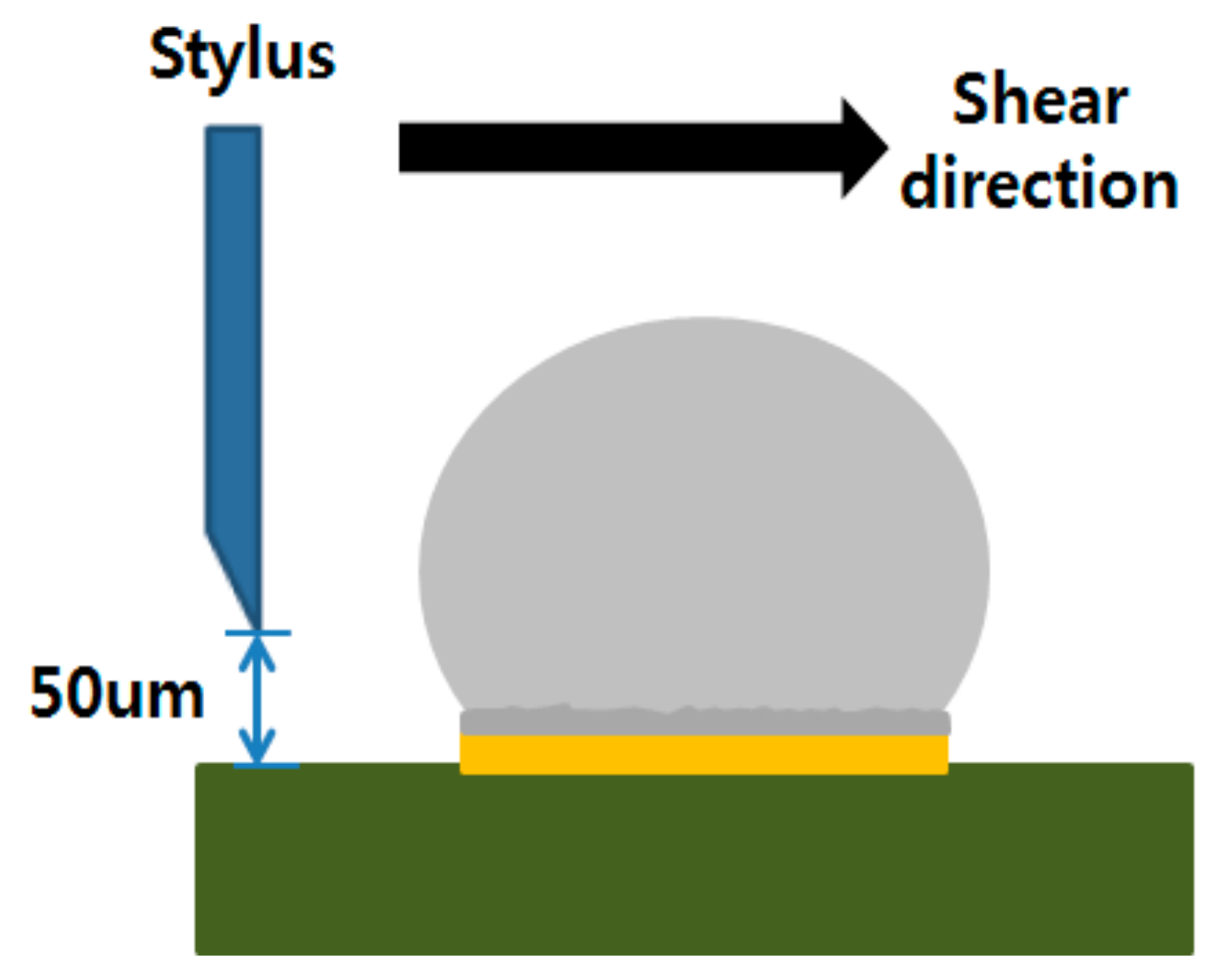
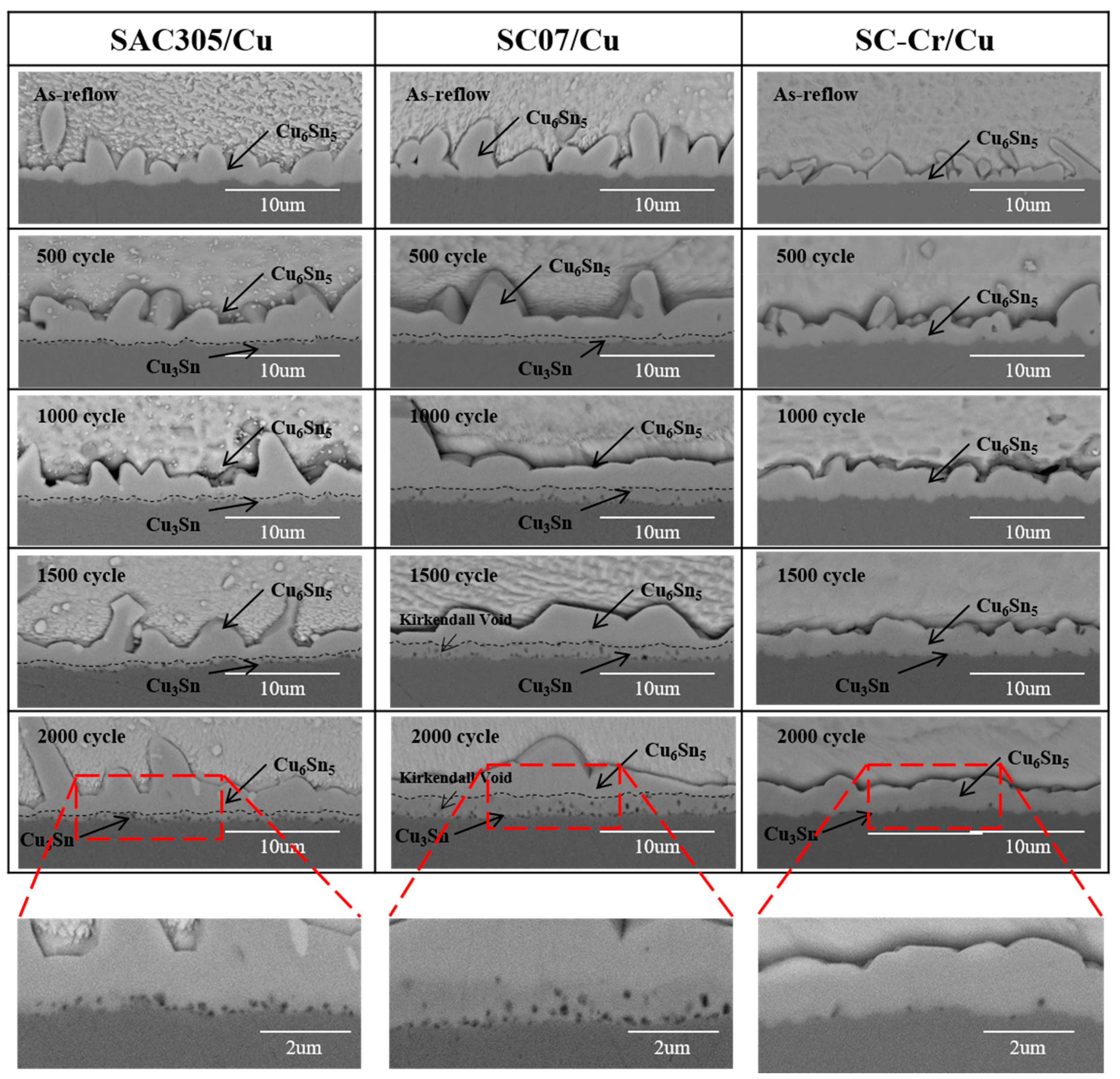



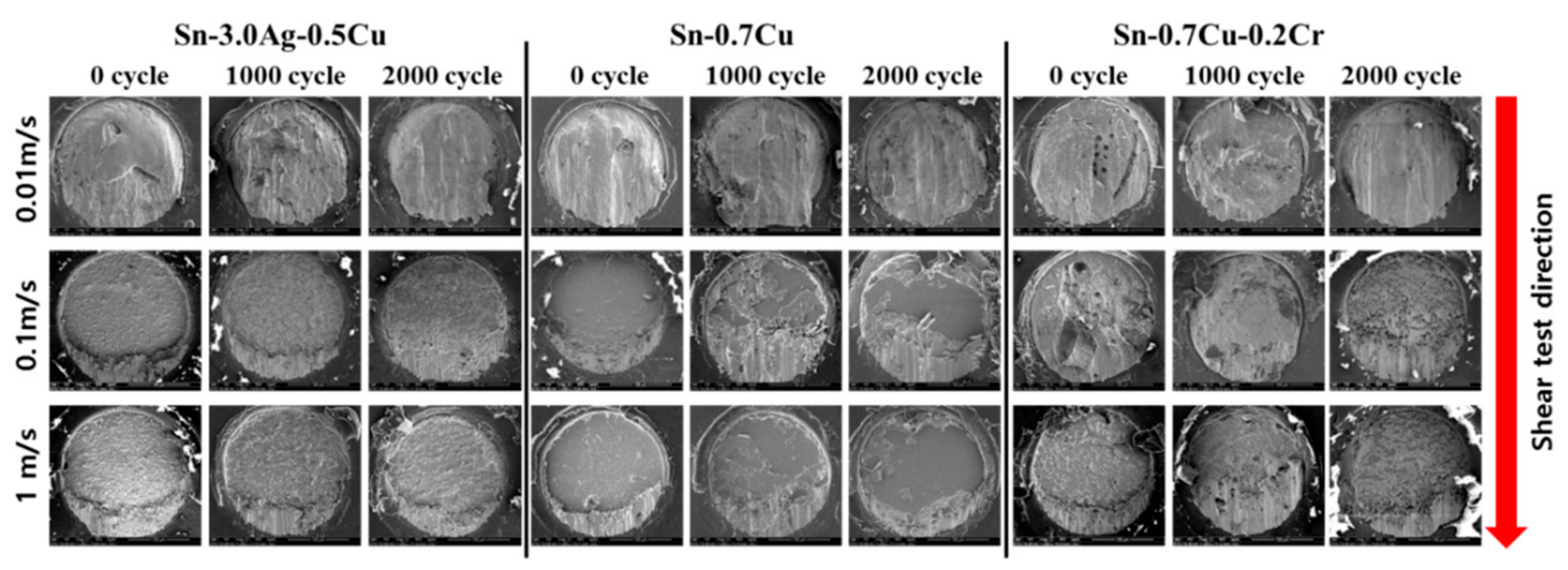
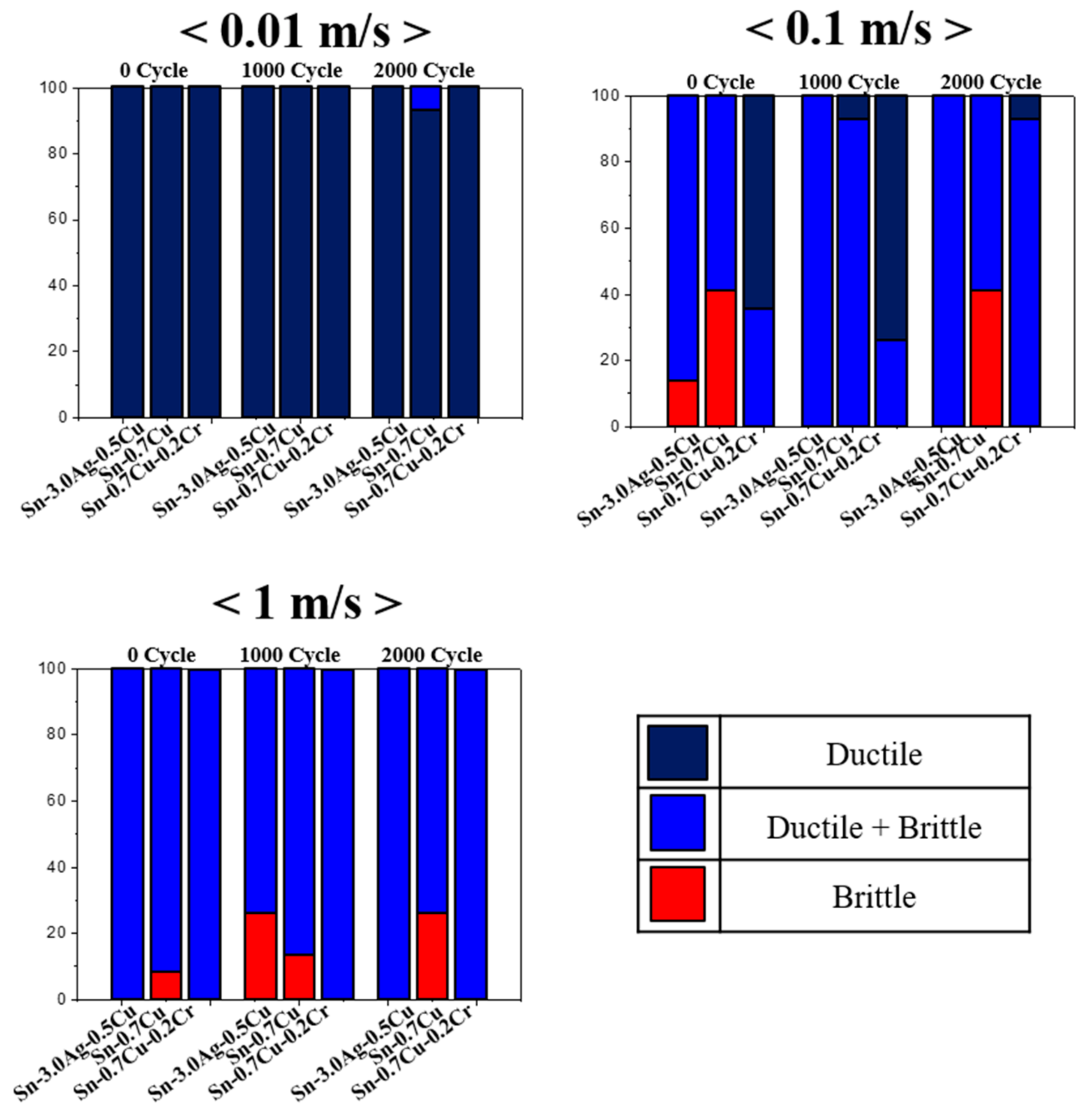

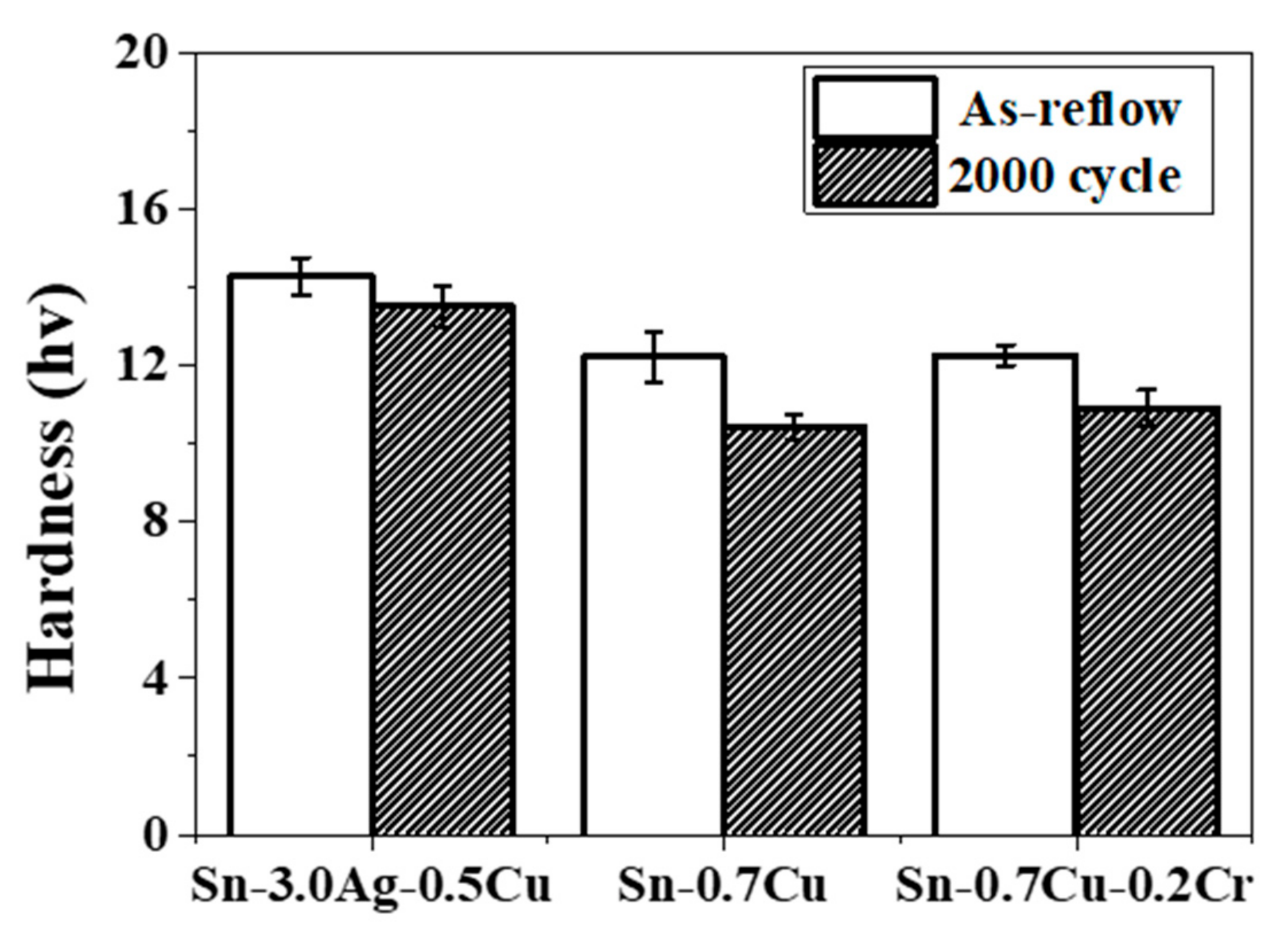
| Solder | Pre-Heating Time (s) | Duration Time above Melting Temperature (s) | Peak Reflow Temperature (°C) |
|---|---|---|---|
| Sn-3.0Ag-0.5Cu | 107 | 53 | 250 |
| Sn-0.7Cu | 73 | 47 | 255 |
| Sn-0.7Cu-0.2Cr | 73 | 47 | 260.5 |
© 2018 by the authors. Licensee MDPI, Basel, Switzerland. This article is an open access article distributed under the terms and conditions of the Creative Commons Attribution (CC BY) license (http://creativecommons.org/licenses/by/4.0/).
Share and Cite
Bang, J.; Yu, D.-Y.; Yang, M.; Ko, Y.-H.; Yoon, J.-W.; Nishikawa, H.; Lee, C.-W. Improvement in Thermomechanical Reliability of Low Cost Sn-Based BGA Interconnects by Cr Addition. Metals 2018, 8, 586. https://doi.org/10.3390/met8080586
Bang J, Yu D-Y, Yang M, Ko Y-H, Yoon J-W, Nishikawa H, Lee C-W. Improvement in Thermomechanical Reliability of Low Cost Sn-Based BGA Interconnects by Cr Addition. Metals. 2018; 8(8):586. https://doi.org/10.3390/met8080586
Chicago/Turabian StyleBang, Junghwan, Dong-Yurl Yu, Ming Yang, Yong-Ho Ko, Jeong-Won Yoon, Hiroshi Nishikawa, and Chang-Woo Lee. 2018. "Improvement in Thermomechanical Reliability of Low Cost Sn-Based BGA Interconnects by Cr Addition" Metals 8, no. 8: 586. https://doi.org/10.3390/met8080586
APA StyleBang, J., Yu, D.-Y., Yang, M., Ko, Y.-H., Yoon, J.-W., Nishikawa, H., & Lee, C.-W. (2018). Improvement in Thermomechanical Reliability of Low Cost Sn-Based BGA Interconnects by Cr Addition. Metals, 8(8), 586. https://doi.org/10.3390/met8080586





